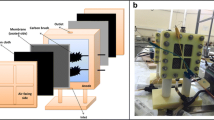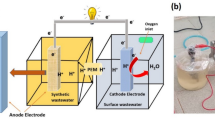Abstract
The present study deals with the capability of pulp industry wastewater to produce bioelectricity with isolation and screening of native electrogenic bacteria from wastewater. In the screening process, three bacterial isolates were obtained; they were studied on the basis of morphology and biochemical characteristics. The maximum bioelectricity producing bacteria was identified by sequencing method and was identified as Pseudomonas fluorescens, and it is a novel bacteria reported in bioelectricity production from pulp industry wastewater. Further, the work focuses on optimization of various parameters, i.e., inoculum size, pH, temperature, mediators and its concentration. It was observed that with pulp industry wastewater, inoculum size of 1.5% gave the maximum voltage and current of 1.244 ± 0.003d V and 5.946 ± 0.005d mA, respectively. A pH of 7.0 gave maximum voltage and current of 0.956 ± 0.009e V and 2.692 ± 0.016e mA. At 35 °C temperature, maximum production of voltage and current of 1.045 ± 0.003d V and 2.167 ± 0.037d mA were recorded. Among the various mediators, humic acid was found to be most effective as it produced a voltage of 1.054 ± 0.004f V and current of 1.070 ± 0.004d mA. Maximum voltage of 1.291 ± 0.021f V and current of 1.896 ± 0.006f mA were recorded with 200 μM of humic acid. Physicochemical analysis of the effluent was conducted before and after experimental run, and the values suggested that the microbial fuel cell technology is an efficient method for biological treatment of wastewater.

Similar content being viewed by others
References
Aldrovandi A, Marsili E, Stante L (2009) Sustainable power production in a membrane-less and mediator-less synthetic wastewater microbial fuel cell. Bioresour Technol 100(13):3252–3260
APHA American Water Works Association (1998) Water Pollution Control Federation. Standard methods for the examination of water and wastewater, 20th edn. American Public Health Association, Washington
Bond DR, Lovley DR (2003) Electricity production by Geobacter sulfurreducens attached to electrodes. Appl Environ Microbiol 69:1548–1555
Choi Y, Kim N, Kim S, Jung S (2003) Dynamic behaviors of redox mediators within the hydrophobic layers as an important factor for effective microbial fuel cell operation. Bull Korean Chem Soc 24:437–440
Dereeper A, Guignon V, Blanc G, Audic S, Buffet S, Chevenet F, Dufayard JF, Guindon S, Lefort V, Lescot M, Claverie JM, Gascuel O (2008) Phylogeny.fr: robust phylogenetic analysis for the non-specialist. Nucleic Acids Res 1:36
Edgar RC (2004) MUSCLE: multiple sequence alignment with high accuracy and high throughput. Nucleic Acids Res 32(5):1792–1797
Gil GC, Chang IS, Kim BH, Kim M, Jang JK, Park HS, Kim HJ (2003) Operational parameters affecting the performance of a mediator-less microbial fuel cell. Biosens Bioelectron 18(4):327–334
Hampannavar US, Anupama, Pradeep NV (2011) Treatment of distillery wastewater using single chamber and double chambered MFC. Int J Environ Sci 2(1):114–123
Holt JG, Krieg NR, Sneath PHA, Staley JT, Williams ST (1994) In Bergey’s manual of determinative bacteriology, 9th edn. Williams and Wilkins, Baltimore
Ieropoulos IA, Greenman J, Melhuish C, Hart J (2005) Comparative study of three types of microbial fuel cell. Enzyme Microb Technol 37:238–245
Khare AP (2014) Voltage produced by different salts concentration on single chamber microbial fuel cell. Int J Eng Sci Res Technol 3(3):1448–1452
Khashe S, Janda JM (1998) Biochemical and pathogenic properties of Shewanella alga and Shewanella putrefaciens. J Clin Microbiol 36(3):783–787
Kim HJ, Park HS, Hyun MS, Chang IS, Kim M, Kim BH (2002) A mediatorless microbial fuel cell using a metal reducing bacterium, Shewanella putrefaciens. Enzyme Microb Technol 30:145–152
Kim BH, Chang IS, Gadd GM (2007) Challenges in microbial fuel cell development and operation. Appl Environ Microbiol 76:485–494
Krishna KV, Sarkar O, Venkata Mohan S (2014) Bioelectrochemical treatment of paper and pulp wastewater in comparison with anaerobic process: integrating chemical coagulation with simultaneous power production. Bioresour Technol 174(2014):142–151
Kumar S, Babu GK (2013) Isolation and identification of nano-wire forming electrogens from Anodic biofilms of the microbial fuel cells (MFCs). Int J Sci Res 4:1803–1808
Kumar S, Bharadwaj Kumar HD, Babu GK (2012) A study on the electricity generation from the cow dung using microbial fuel cell. J Biochem Technol 3(4):442–447
Larrosa-Guerrero A, Scott K, Ian M, Mateo F (2010) Low temperature performance of microbial fuel cells. Chem Eng Trans 21:463–468
Liu H, Ramnarayanan R, Logan B (2004) Production of electricity during wastewater treatment using a single chamber microbial fuel cell. Environ Sci Technol 38:2281–2285
Logan BE (2010) Scaling up microbial fuel cells and other bioelectrochemical systems. Appl Microbiol Biotechnol 85:1665–1671
Logan BE, Murano C, Scott K, Gray ND, Head IM (2005) Electricity generation from cysteine in a microbial fuel cell. Water Resour 39:942–952
Mathis BJ, Marshall CW, Milliken CE, Makkar RS, Creager SE, May HD (2008) Electricity generation by thermophilic microorganisms from marine sediment. Appl Microbiol Biotechnol 78:147–155
Mocali S, Galeffi C, Perrin E, Florio A, Migliore M, Canganella F, Bianconi G, Mattia ED, Dell’Abate MT, Fani R, Benedetti A (2013) Alteration of bacterial communities and organic matter in microbial fuel cells (MFCs) supplied with soil and organic fertilizer. Appl Microbiol Biotechnol 97:1299–1315
Nimje VR, Labrath YP, Gaikar VG (2013) Development of microbial fuel cell using distillery spent wash: evaluation of current generation and COD removal with respect to pH. Iran J Energy Environ 4(4):348–356
Pant D, Van Bogaert G, Diels L, Vanbroekhoven K (2010) A review of the substrates used in microbial fuel cells (MFCs) for sustainable energy production. Bioresour Technol 101:533–1543
Park DH (1999) Microbial utilization of electrically reduced neutral red as the sole electron donor for growth and metabolite production. Appl Environ Microbiol 65:2912–2917
Park DH, Zeikus JG (2000) Electricity generation in microbial fuel cells using neutral red as an electronophore. Appl Environ Microbiol 66:1292–1297
Patil SA, Surakasi VP, Koul S, Ijmulwar S, Vivek A, Shouche YS, Kapadnis BP (2009) Electricity generation using chocolate industry wastewater and its treatment in activated sludge based microbial fuel cell and analysis of developed microbial community in the anode chamber. Bioresour Technol 100:5132–5139
Patil VD, Patil DB, Deshmukh MB, Pawar SH (2011) Comparative study of bioelectricity generation along with the treatment of different sources of wastewater. Int J Chem Sci Appl 2(2):162–168
Prescott LM, Harley JP (2002) Laboratory exercises in microbiology, 5th edn. McGraw Hill, New York
Rabaey K, Lissens G, Siciliano SD, Verstraete W (2003) A microbial fuel cell capable of converting glucose to electricity at high rate and efficiency. Biotechnol Lett 25(18):1531–1535
Rabaey K, Rodríguez J, Blackall LL, Keller J, Gross P, Batstone D, Verstraete W, Nealson KH (2007) Microbial ecology meets electrochemistry: electricity-driven and driving communities. Int Soc Microb Ecol 1:9–18
Raghavulu SV, Venkata Mohan S, Goud RK, Sarma PN (2009) Effect of anodic pH microenvironment on microbial fuel cell (MFC) performance in concurrence with aerated and ferricyanide catholytes. Electrochem Commun 11:371–375
Sethia K, Kaushik A, Jadhav SK, Quraishi A (2015) Effect of operational parameters on cow dung mediated microbial fuel cell. World J Eng 12(6):541–550
Talavera G, Castresana J (2007) Improvement of phylogenies after removing divergent and ambiguously aligned blocks from protein sequence alignments. Syst Biol 56:564–577
Thakur V, Tiwari KL, Jadhav SK (2015) Production of biohydrogen from wastewater by Klebsiella oxytoca ATCC 13182. Water Environ Res 87(8):683–687
Tiwari S, Jadhav SK, Tiwari KL (2015) Bioethanol production from rice bran with optimization of parameters by Bacillus cereus strain McR-3. Int J Environ Sci Technol 12:3819–3826
Wei L, Han H, Shen J (2013) Effects of temperature and ferrous sulfate concentrations on the performance of microbial fuel cell. Int J Hydrogen Energy 38:11110–11116
Yong YC, Yu YY, Li CM, Zhong JJ, Song H (2011) Bioelectricity enhancement via overexpression of quorum sensing system in Pseudomonas aeruginosa-inoculated microbial fuel cells. Biosens Bioelectron 30:87–92
Zhang Y, Min B, Huang L, Angelidaki I (2009) Generation of electricity and analysis of microbial communities in wheat straw biomasses-powered microbial fuel cells. Appl Environ Microbiol 75(11):3389–3395
Zhang T, Zhang L, Su W, Gao P, Li D, He X, Zhang Y (2011) The direct electrocatalysis of phenazine-1-carboxylic acid excreted by Pseudomonas alcaliphila under alkaline condition in microbial fuel cells. Bioresour Technol 102:7099–7102
Acknowledgements
The authors would like to thank The Department of Biotechnology (DBT), Government of India, New Delhi for providing fellowship for this research work and also thankful to the DST-FIST. This work was supported under Grant No. DBT-JRF/2012-13/90.
Author information
Authors and Affiliations
Corresponding author
Additional information
Editorial responsibility: Necip Atar.
Electronic supplementary material
Below is the link to the electronic supplementary material.
Rights and permissions
About this article
Cite this article
Kaushik, A., Jadhav, S.K. Conversion of waste to electricity in a microbial fuel cell using newly identified bacteria: Pseudomonas fluorescens . Int. J. Environ. Sci. Technol. 14, 1771–1780 (2017). https://doi.org/10.1007/s13762-017-1260-z
Received:
Revised:
Accepted:
Published:
Issue Date:
DOI: https://doi.org/10.1007/s13762-017-1260-z




